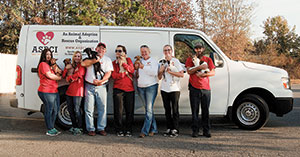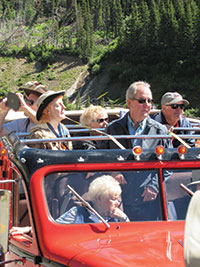
Story by Carol Pappas
Photos by Susan Wall and Arline Lynch
On a brisk Saturday morning this fall, a group of foster parents gathered in a Pell City parking lot to say their goodbyes. In their care had been 25 puppies — loved, nurtured, protected – as if they were their own.
Just like a sleeping infant finds solace in the crook of a strong, comforting arm, these wide-eyed puppies had found their haven, if only for a little while. On this November morning, they were about to find even more. Tears and smiles intermingled as farewells and a final hug marked the occasion. It was time, time to head to their permanent, “forever home.”
The same scene plays out each month as ASPCI, Animal Shelter of Pell City Inc. volunteers give up their precious cargo for what they know will become the life their four-footed friends deserve.
The road to this point
Happy endings weren’t always the case in St. Clair County for dogs and cats, puppies and kittens. Turn back the clock a couple of decades, and there was no animal shelter, no caring group to come to the rescue.
But a handful of persevering St. Clair Countians pushed, prodded, rolled up their sleeves and went to work to establish a safe place and a system to take care of them. It took different forms in the early years, but it finally emerged from their dreams and into a real animal shelter built in Pell City with the dollars they raised. And ASPCI was born.
 The organization is still evolving. It no longer is affiliated with the shelter they built, manned and enhanced. They have moved exclusively to the original goal – finding as many forever homes as they can for the county’s animal population.
The organization is still evolving. It no longer is affiliated with the shelter they built, manned and enhanced. They have moved exclusively to the original goal – finding as many forever homes as they can for the county’s animal population.
“The things we did inside that building that brought pleasure to our heart is what we’re doing now,” said Barbara Wallace, the organization’s president.
Operating from an administrative office on US 231 South in Pell City, they welcome volunteers on board, recruit foster parents, sell spay and neutering certificates and best of all, they help find forever homes through other shelters with the same caring goal.
“The thing I am proudest of is that the group that started the shelter has stayed together,” said Sandra Embry, a former president, memorial chairman and one of the early movers and shakers to get the job done. “There has never been any disagreement between any of us. This group stayed together for 15 years, and that’s pretty remarkable.”
There is no mistaking Embry’s passion. From the thousands of handwritten thank you notes to adopters and contributors she must have written over the years to the sound of her words as she speaks, her overriding love of animals is ever present. “They have no voice. We’re their voice. That’s what it comes down to.”
It’s difficult to tell her passion from that of Sylvia Martin. She and Karen Thibado helped found the fundraising gala, Fur Ball, now called Mardi Paws Fur Ball. It is the organization’s major fundraiser and has become one of the signature social events of the year. Her handiwork was seen in Doo Dah Day, which became Paws in the Park – an outdoor celebration of people’s precious pets and an opportunity to raise awareness about those animals who were not so lucky.
When Martin saw a need, she set about to fill it. In the 1970s, the lakeside area in which she lived was a destination point for abandoning dogs because it wasn’t developed as much. “My limit was six (dogs). I kept six – all strays except two,” Martin said. “There wasn’t any program about spaying and neutering. There wasn’t a leash law.”
Over the years, that all changed, and Martin and others were a part of that group that brought the improvements about. They pushed for education programs, spaying and neutering and enforced laws. “It was a community effort,” she said, noting that it took “years and years of people donating time and money. Everybody involved had a real love for animals.”
Others came on board, trading day jobs and management positions for a broom or mop or manning the phones. Jo Mitchell and husband Marty Kollmorgen were among them. Mitchell’s husband was an executive, a division manager with AT&T, but it was not unusual to spot him cleaning kennels and doing what needed to be done. After Mitchell retired, she became more and more involved and has served as treasurer since 2006.
Wallace, a friend of Mitchell’s, got involved the same way. After her retirement and a time of caretaking for her mother, who was ill, she joined the organization. Paws in the Park planning was under way at the time. “I needed something to do, and they needed help,” Wallace recalled. “It went from there. I enjoy it.”
Every organization needs an historian. Arline Lynch, camera in hand, has been instrumental in preserving the history of people and events that marked the success of ASPCI over the years through her photographs. Her remembrances are especially helpful in ensuring that the long list of people who wrote this success story aren’t forgotten. “So many have helped through the years and continue to do so,” she said.
It is impossible to name them all. Their stories are not unusual. It is one of identifying needs and working to make sure they are fulfilled.
Arlene Johnson was involved at the beginning of the organization’s nonprofit status in 1995. “I was recruited by the first President, Herb Doynow. Herb and his wife, Billie, (both now deceased) were neighbors in the Seddon Point area where I lived at the time,” Johnson said. Herb and his wife had several cats who were taken care of at Dr. Galen Sims at Cropwell Small Animal Hospital. The Doynows learned of the need for a local shelter from Galen as there was no shelter anywhere in St. Clair County.”
At the time, local animals taken into custody by animal control officers were delivered to the Birmingham pound. Herb had a home-based business and his wife provided his office support, and they filed the first 501c3 papers with the help of Jan and Charles Trotter.
“Our first board consisted of Herb as president, Galen as vice president, Billie as treasurer, and me as secretary. I served two three-year terms as president the first period between 2000 and 2003.” She also served as vice president, treasurer, secretary, newsletter chair and fundraising chair. “Pat Tucker was the president prior to me and was instrumental in gathering local support and improving the fundraising aspect of our mission. She remained active in ASPCI business and fundraising until moving back to Georgia to be near her mother about five years ago,” Johnson said.
 In 2000, the shelter opened on a piece of property across from St. Clair County Airport. The organization that had started out as a rescue organization had to meet the immediate needs of the community as an intake facility for the county and cities in St. Clair County and adjacent communities who were legally required to operate or contract for a pound. So, through the commitment of the Pell City Council, St. Clair County Commission, and many local business supporters, including the Airport Authority, Alabama Power, Goodgame Company, many other local small businesses, all local veterinarians, several individuals and regional and national animal foundations, funds were secured to build, furnish and operate the facility.
In 2000, the shelter opened on a piece of property across from St. Clair County Airport. The organization that had started out as a rescue organization had to meet the immediate needs of the community as an intake facility for the county and cities in St. Clair County and adjacent communities who were legally required to operate or contract for a pound. So, through the commitment of the Pell City Council, St. Clair County Commission, and many local business supporters, including the Airport Authority, Alabama Power, Goodgame Company, many other local small businesses, all local veterinarians, several individuals and regional and national animal foundations, funds were secured to build, furnish and operate the facility.
“The most challenging aspect was the first 10 years of operation when the intake from animal control officers as well as the animals surrendered from their owners grew from about 300 animals a month to at a peak of over 800 a month,” Johnson said. “The shelter facility had to grow with more workers, volunteers and space to handle the incoming animal population. Most citizens don’t realize the volume of unwanted animals in their community, but many households with animals contribute to the problem by not spaying and neutering their pets.”
Gene Morris, a telephone company officer, well remembers those early years and the impact of the group. He joined the board shortly after 2000 and served as treasurer for many years. “Several executive level people were running the group for free as a good service to the community. It wasn’t long before the community saw very few stray animals.”
Mission Continues
Today ASPCI’s mission remains strong – “to rescue/adopt as many as possible, offer low-cost spay-neuter certificates, and to remain visible and have a voice in the community,” Johnson said. They take in animals from other shelters, get their shots, arrange for foster care and adoptions. Through rescue agreements with other shelters, the animals in their care now have forever homes throughout the country.
Their stories and updates appear on ASPCI’s Facebook page, usually accompanied by a photo and a big thank you to the organization for uniting the pet and the family.
They also take rescues to Pet Smart in Trussville as part of the adoption program. Facebook also is one of their tools for adoption, where they post photos, names and descriptions of adoptable pets.
They operate a Managed Admission Program locally, where they work with people who may not be able to keep a pet and assess if they can facilitate adoption. Or, someone may just need help with providing food, and ASPCI steps in to help.
They work with Lakeside Hospice in a program called Pet Peace of Mind, where hospice patients may not be able to take care of their pets any longer. ASPCI is there to ensure they find another loving home. And they own and operate a pet cemetery in Moody.
Organizations like ASPCI are only as strong as the people who are involved in it. Just as those who have come before to build a strong foundation and continue their support to this day, fosters are key to the group’s success. They keep adoptable animals two to four weeks in their homes to allow time to arrange for adoptions and rescue runs to other shelters en route to forever homes.
Tammy Hart serves as foster, rescue and adoption coordinator. A computer engineer by trade, she represents a new generation of ASPCI volunteers, getting involved just four years ago. “It is one of the most rewarding thigs I’ve done,” she said, noting that through fostering, she has helped save hundreds of animals.
People may be reluctant to foster, Hart said, because they say ‘they can’t give them up.’ She is quick to tell them, “When they go, you know they are going to a good home. If you don’t let them go, you can’t make room for others.”
They find comfort in those words and the compassion behind them. Fosters are a dedicated group that finds rewards in the work they do to unite pets with their forever homes, just like Embry and others who came long before them.
Embry shared a poem by Helen Inwood, whose words, she said, “spoke to my heart so deeply many, many years ago….and has been my mantra always.” It is the same mantra that ASPCI seems to bring to life in the work it does.
All involved would simply tell you it is a labor of love. To Pell City and St. Clair County, it has been an answered prayer.
PRAYER FOR THE HELPLESS
Let me be a voice for the speechless,
Those who are small and weak;
Let me speak for all helpless creatures
Who have no power to speak.
I have lifted my heart to heaven
On behalf of the least of these-
The frightened, the homeless, the hungry, I am now voicing their pleas.
If I can help any creature,
Respond to a desperate call,
I will know that my prayer has been answered By the God Who created them ALL.
To learn more about ASPCI or to donate, go to aspci.org or follow on Facebook. Mardi Paws Fur Ball is March 3 at Celebrations, the group’s major fundraiser for the year, and support is encouraged.














 Story by Paul South
Story by Paul South So in 2001, Burttram and Don Dollar, Merle’s former husband, decided to open a different kind of place. At the same time, Merle and her sisters were renovating the site of what’s now Local Color.
So in 2001, Burttram and Don Dollar, Merle’s former husband, decided to open a different kind of place. At the same time, Merle and her sisters were renovating the site of what’s now Local Color. “We’re not fussy, not prissy, but we do try to keep it classy. Dinner is served from 6 to 7:30, then the lights go down and the performance begins. Quiet from the audience is expected.
“We’re not fussy, not prissy, but we do try to keep it classy. Dinner is served from 6 to 7:30, then the lights go down and the performance begins. Quiet from the audience is expected. “We looked at it as one of the strong suits for playing there,” he said.
“We looked at it as one of the strong suits for playing there,” he said. Indeed, they have. But Merle and Garry have decided to close up shop, to enjoy retirement and do other things. It’s something they’ve kicked around for years.
Indeed, they have. But Merle and Garry have decided to close up shop, to enjoy retirement and do other things. It’s something they’ve kicked around for years.

 One of the organization’s key goals is to be designated as a Main Street Alabama community. Main Street Alabama’s focus is on “bringing jobs, dollars and people back to Alabama’s historic communities,” and to revitalize city centers and neighborhoods, according to the Main Street Alabama website.
One of the organization’s key goals is to be designated as a Main Street Alabama community. Main Street Alabama’s focus is on “bringing jobs, dollars and people back to Alabama’s historic communities,” and to revitalize city centers and neighborhoods, according to the Main Street Alabama website. Pell City already has certain areas designated for their historical significance, like the Mill Village. Downtown is in a nationally-designated historic district, as is the residential area behind the St. Clair County Courthouse and Cogswell Avenue. Historical markers aimed at drawing people from nearby Interstate 20 to the downtown area would help boost those districts.
Pell City already has certain areas designated for their historical significance, like the Mill Village. Downtown is in a nationally-designated historic district, as is the residential area behind the St. Clair County Courthouse and Cogswell Avenue. Historical markers aimed at drawing people from nearby Interstate 20 to the downtown area would help boost those districts.

 Members keep a close watch on weather forecasts and some of them use special-purpose apps that predict when the skies will be clear. They are helpful but not perfect.
Members keep a close watch on weather forecasts and some of them use special-purpose apps that predict when the skies will be clear. They are helpful but not perfect. Deramus said he was interested as a kid, but it was a college class in astronomy that got him hooked.
Deramus said he was interested as a kid, but it was a college class in astronomy that got him hooked.
 Four-legged friend learning to help others
Four-legged friend learning to help others She asked about his temperament, and the man replied, “He sleeps in the bed with us. He doesn’t shed.” Then, he added, “He loves to swim. He has webbed feet.”
She asked about his temperament, and the man replied, “He sleeps in the bed with us. He doesn’t shed.” Then, he added, “He loves to swim. He has webbed feet.”

 The trip was part of an annual trek by Friends Bound for New Horizons, a group formed to travel the world while helping raise money for the Pell City Schools Educational Foundation and the Pell City Library. What an intriguing concept. Through travel, we learned our own lessons about the world, which in turn, will in myriad ways provide resources for children and adults alike to learn about the world.
The trip was part of an annual trek by Friends Bound for New Horizons, a group formed to travel the world while helping raise money for the Pell City Schools Educational Foundation and the Pell City Library. What an intriguing concept. Through travel, we learned our own lessons about the world, which in turn, will in myriad ways provide resources for children and adults alike to learn about the world. Our mode of transportation was in Red Jammers. These are specially designed vintage 1930s buses with four rows of seats. The fabric tops can be rolled back on pleasant days for passengers to gain a better vantage point of the views as they head up to the pass. That day was a pleasant day in more ways than just the weather as we climbed higher and higher in our Red Jammers with incredible views all around.
Our mode of transportation was in Red Jammers. These are specially designed vintage 1930s buses with four rows of seats. The fabric tops can be rolled back on pleasant days for passengers to gain a better vantage point of the views as they head up to the pass. That day was a pleasant day in more ways than just the weather as we climbed higher and higher in our Red Jammers with incredible views all around. We started our trip early that morning, traveling on the Icefields Parkway. Along the way was a kaleidoscope of cliffs, waterfalls, rushing rivers, glacial peaks and snow covered mountain ranges. In short, all were sights to behold in awe.
We started our trip early that morning, traveling on the Icefields Parkway. Along the way was a kaleidoscope of cliffs, waterfalls, rushing rivers, glacial peaks and snow covered mountain ranges. In short, all were sights to behold in awe.






































































